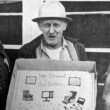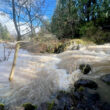By Roberta McKern
For The New Era
The Oregon Volunteer Cavalry played a significant role in maintaining order and protecting settlements throughout the Pacific Northwest during the American Civil War. Organized in response to growing unrest and the need for military presence on the frontier, these volunteers faced challenging conditions, including difficult terrain, supply shortages, and frequent skirmishes with local tribes.
Despite these hardships, their dedication and service contributed greatly to the stability of the region between 1861 and 1864.
The East Linn Museum has received a “new” used book, a reprint of “General History or Oregon” put out by Binford and Mort in 1971 authored by Charles H. Carey, LLD, who died in 1941.
The history of Oregon’s early days, the book is considered definitive. A lawyer, Carey had a meticulous legal mind, plus a continuous interest in Oregon history and had served for many years as head of the Oregon Historical Society, leaving behind a body of well-respected work.
As we plunged into the book, we were disappointed to discover it did not continue into the 20th century, leaving off with the Civil War years, for the most part.
But what we still know of Oregon during that time of 1860-65 is limited. For example, here in the Willamette Valley, a clandestine organization called “Knights of the Golden Circle” flourished for a time. After all, at the war’s beginning it seemed the South was winning.
They had seized the initiative and Oregon’s Gov. John Whiteaker, the state’s first, fearing the South with its “Peculiar Institution” could not be defeated said, “Have a care that in freeing the negro, you do not enslave the white man.”
The Knights of the Golden Circle gained so much popularity they recruited at the state fair and initiated several members. They proposed to resist the draft, should one be called, and discussed becoming part of the Republic of the Pacific, a movement to form an independent, separate nation in the Western United States.
But mainly they worried about whether to call themselves Knights of the Golden Circle or The Olde Guard or Friends of the Union, although their sympathies were with the South. Pro-unionists came up with their own version of a patriotic organization called “The League of Americans for the State of Oregon,” but it was too big a mouthful and never gained popularity like the Knights of the Golden Circle.
Oregon had cast most of its electoral college votes for Abraham Lincoln in the 1860 election with one for Breckenridge and was primarily anti-slavery in sentiment.
However, Gov. Whiteaker had plenty of southern rhetoric, and this disjuncture put Oregon behind the anti-secession group at the start of the war.
A real blow happened when Oregon’s cavalry contingent was recalled. Those in Washington DC seemed to give little thought to the states and territories located at a distance, treating them like stepchildren reluctant to give adequate support to the eastern government sitting face to face with the uncertainties of the rebellion.
Thus, as the federal cavalry was ordered east, Oregon was urged to call up its own troops.
Oregon cavalry officers were appointed with the intent that they enlist the needed number of young men, none of whom would grow wealthy in the cavalry. For three years’ service, an enlistee was promised $31 dollars a month plus 40 cents per day for use of his horse and equipment, which the recruit had to furnish.
A good horse could cost from $150 to $250, and 40 cents a day for the horse was subject to recall.
In some respects, the American Congress proved to be a bane to the Oregon cavalry. Long complaints about broken Indian treaties had a certain truth to them. It was not that the treaties were necessarily made in bad faith, but Congress back in Washington DC took its time about ratifying them, sometimes amounting to two or three years, while those who believed in the treaties settled on supposed ceded lands.
We can speculate about the slowness of Congress to act in the years leading up to the Civil War. Anti-slavery people wanted votes to go in their favor, but pro-slavery ones had no desire to encourage passage of legislation favoring areas where slavery was restricted.
When Oregon set about forming its own cavalry, enlistees did not rush to recruiters to answer the call to arms and different tricks were used to bring them in, like having counties in the Willamette Valley vie to see which could raise the first regiments A or B.
Polk County won. One recruiter solved his problem by going to California and signing up men from there.
With its loss of cavalry, the state gained a definite Indian problem as did much of the frontier east of the mountains from Minnesota down through west Texas, Montana and the Dakotas.
As troops were whipped out and headed east for big battles of the war, Indian leaders took notice.
Along with gold strikes at Baker City and in the John Day region, and along the Idaho border, as Carey notes, a different type of immigrant was entering the scene although one which should have been families from the 1849 California gold rush days. Men interested more in striking it big than settling down with a family, had exploitation in mind.
The work of the Oregon cavalry on the eastern and southern frontier in the 1860s seems to have assumed a certain regularity. Sometimes they pursued hostiles. If the Indians proved to have practiced depredations, they might be shot or hanged.
Generally, the Oregon cavalry practiced respect toward non-threatening Indians, but harsher punishment could be meted out by volunteer militia eager to eradicate an annoying problem.
As it was, some friendly Indians assisted the cavalry as unpaid guides, depending on whether foes were being chased. Cavalry members wished Indian guides could be hired, but that did not occur until later.
Some Indians, like the Nez Perce, were held in high esteem.
Yet, young Oregon men grew disillusioned with service in the states cavalry units when their hope was to court glory across the Mississippi River or on the banks of the Potomac.
Their general fate was to explore eastern and southern Oregon in desiccated conditions which tried the health of their horses. Left with jaded mounts at the end of the war, they would find the War Department was shying away from even paying the 40 cents per day allotment to help see to the health of the animals.
Even before the war erupted at Fort Sumpter, in 1860 unrest on the Oregon-Idaho border began to grow.
Two raids were made against the Warm Springs Indian reservation, and a massacre took place at Salmon Falls near Boise, Idaho, bad enough to influence future skirmishes between the cavalry men and disaffected Indians as those fomenting violences were often called.
We, at the museum, decided that if Judge Carey could include the bald-faced truths, so might we when it came to the massacre.
An incident which occurred shortly before the North and South took up arms emphasizes how important having a cavalry was to Oregon. This was the Myers Massacre and in recording it, Carey let it speak for itself.
It was called that after the husband, wife and five children who were among the survivors. The party of forty-four immigrants had been conveyed by the U.S. Army to a point a short distance from Fort Hall near Boise, Idaho. The army then left the party in supposed security.
On Sept. 13, 1860, a band of a hundred Bannocks surrounded them. The Bannocks first demanded food as presents, then they drove off the party’s cattle, and followed by an attack on the immigrants themselves, killing 11, including one woman and two children.
Abandoning their wagons, the surviving immigrants fled. They were pursued, six being killed near Burnt River and one more near the Owyhee. The fate of two girls and two boys was never discovered but some thought they had been taken as slaves by the Bannocks.
Five persons starved to death, two discharged soldiers took firearms and deserted the company, claiming they’d bring help. Subsequently, they too were found dead.
Out of the original forty-four people, only fifteen survived in part by eating the bodies of four children who had died. They spent forty-four days of incredible hardship before being taken care of by members of the Ninth cavalry under Capt. Frederick I. Dent, the brother-in-law of the future general and President Ulysess S. Grant.
At the end of the Civil War in 1865, Congress cut back on military personnel, too far back, leading to warfare in the intermountain area with serious consequences like Custer’s well publicized “Last Stand”. Congress would even decrease pension money meant to aid aging Oregon cavalry members. The forty cents a day meant to fund the trooper’s well used horse had gone by the board long ago.
When we look at the past, we often imagine a golden age, but as Carey’s book shows, a lot of what we imagine is fools’ gold. When the Myers massacre took place in the 1860s, the nation was indecisively bending over the blade of the sword and deciding to engage in a war in which hundreds of thousands of young Americans would die. The massacre likely looked as bad as it could and words of it spurred attitudes of revenge which would shape the future.
Now we are pleased to read Charles H. Carey’s carefully researched work thanks to Binford & Mort’s desire to publish histories of Oregon’s past. As we look around the East Linn Museum, we can spy two cavalry sabers. Maybe one was used by a man riding pell-mell around eastern and southern Oregon, pursuing hostiles.
(A note: Last time we wrote about the War of 1812 and claimed Beethoven wrote the 1812 Overture. He did not, but the Russian Tchaikovsky did.)





